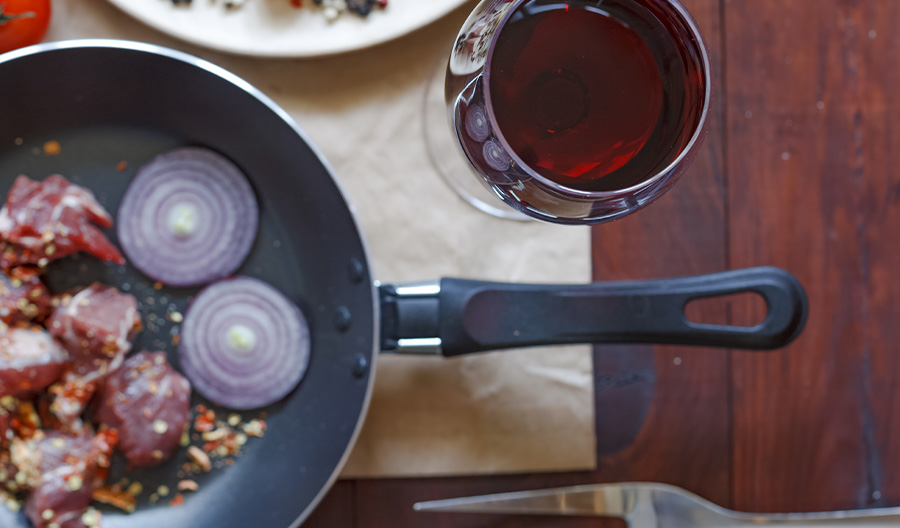Choosing the right cooking wine can be tricky. While you certainly don’t want to pour an investmentbottle into a bubbling stew, in most circumstances, you don’t want to toss in a subpar wine, either. Why? The wine you use will affect the finished flavors of your dish—just as any other ingredient would.
The particular variety, producer, or region doesn’t matter as much as the style of wine. For instance, a hearty, tannic red is suited to different recipes than a light-bodied white or fortified wine.
However, if it’s a bottle you might otherwise drink, it’s suitable for cooking.
Here’s a quick guide to cooking with wine, plus how to find the right wine for every recipe.
Why Cook With Wine
There are several reasons a recipe might call for wine instead of broth or water. In addition to providing nuanced flavors, wine reacts to high temperatures and many ingredients differently than other cooking liquids.
Deglazing
This fancy-sounding term is actually dead simple. Deglazing means pouring liquid into a hot pan you’ve used to cook something in order to release the browned bits stuck to the bottom. In classical French cooking, those caramelized particles are called fond and are prized for the rich flavors they provide.
Here’s how it looks in practical terms: Let’s say you saute chopped onions in olive oil until they start to brown, and then pour in a splash of wine and stir. Congratulations! You just deglazed that pan. Together, the onion particles and wine make a delicious pan sauce to pour over cooked vegetables or proteins, or to serve as the base of a braised dish like osso buco.
In a pinch, or if you’re cooking for someone who doesn’t want to consume any alcohol, you can deglaze with broth or water. However, the chemical makeup of wine is ideal because wine bonds with fat and water molecules. That means it can incorporate more components of the fond than other liquids.
Reductions
If you simmer liquid until some of its water content evaporates, you’re left with a thicker, richer-tasting solution called a reduction. Wine reductions are especially useful because they incorporate theflavors and textures of wine, but eliminate its boozy burn. (Alcohol has a lower boiling point than water—173.1°F versus water’s 212°F—so it evaporates quicker.)
Keep in mind that wine reductions do contain some alcohol, however. The amount depends on how long you simmered the wine, the other ingredients with which it’s cooked and the pan in which it’s cooked. According to one USDA-funded study, after cooking, boozy dishes can retain anywhere from 4 to 95% of their original alcohol content

Braising
If you cook something for a long time in a small amount of barely simmering liquid, that’s called braising. It’s a close relative to stewing, which entails more liquid, and poaching, which is faster and uses higher temperatures.
Wine makes a great braising liquid because it brings ample flavors and textures, and all that slow simmering means that most (though, again, not all) of the alcohol cooks off. What you’re left with is a richly viscous sauce and a fork-tender protein.
How to Choose a Cooking Wine
Be strategic about the wines you decide to cook with and why.
Unless a dish especially calls for a fortified or dessert wine, the best wines for cooking are dry red or dry white wines. For example, if you’re using red, reach for Merlot instead of Port. Or, choose Sauvignon Blanc over Sauternes when you’re cooking with white wine.
If you’re braising or deglazing, variety is less important than the style. The only dry red or white wines to avoid when cooking are heavily oaked bottles, which can develop bitter flavors when cooked. So, save that oak-aged Napa Cabernet Sauvignon or buttery Chardonnay for another purpose.
Otherwise, choose your cooking wine by considering what you might drink with the finished dish. If you’re deglazing a pan to make a sauce for sauteed chicken or pork, a medium-bodied dry white wine like Vermentino or light-bodied dry red like Gamay will work beautifully. Similarly, cuts of lamb or beef typically pair well with dry red wines, which is why dry Zinfandel works so well in this braised short ribs recipe.
As with most wine pairings, however, strict rules need not apply. You can absolutely braise red meat with white wine. Case in point, this crowd-pleasing white wine-braised beef with star anise.
The particular type of dry red or white wine typically matters more in a reduction. Reducing wine concentrates its acidity and sweetness. If you find a wine too honeyed or tart, a reduction will simply amplify those flavors.
To pick the best red or white wine to reduce, consider the flavors of your recipe. If you find a bottle of Gewurztraminer too floral to enjoy drinking, you’re not going to love it in these savory cannellini beans. Similarly, a dry but jammy red wine like a California red blend would suit the reduction in these red wine brownies, but could taste cloying in this tangy barbecue-sauced turkey, which might be better with a less fruity red, like many Tempranillos.
Substitutions for Cooking Wine
If you’re halfway through a recipe and realize you don’t have the right or any cooking wine, don’t fret. Substitute chicken, beef or vegetable broth, or consider other bottles from your liquor stash.
Vermouth is another option, but it’s recommended to proceed with caution since not all vermouths go with all dishes.

